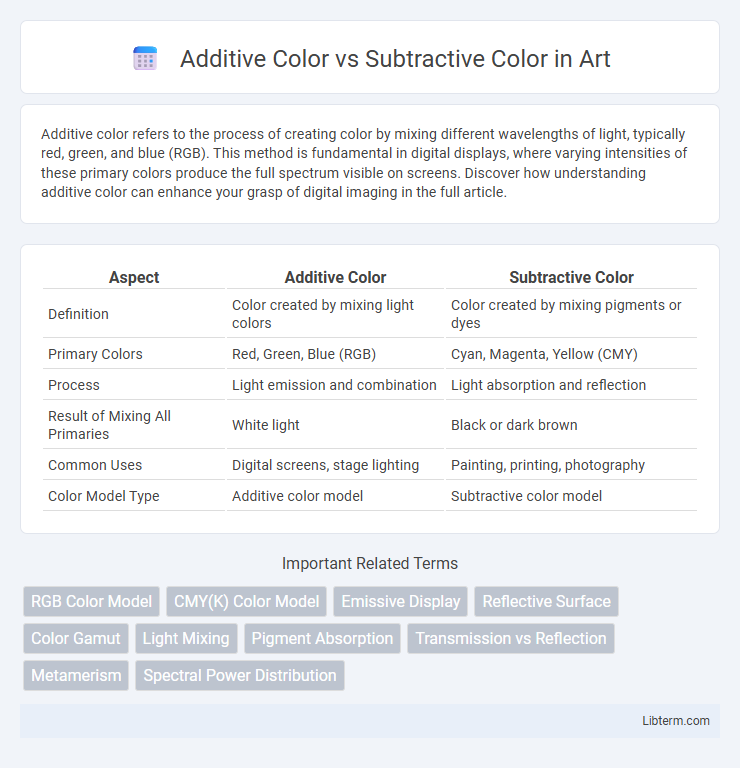Additive color refers to the process of creating color by mixing different wavelengths of light, typically red, green, and blue (RGB). This method is fundamental in digital displays, where varying intensities of these primary colors produce the full spectrum visible on screens. Discover how understanding additive color can enhance your grasp of digital imaging in the full article.
Table of Comparison
| Aspect | Additive Color | Subtractive Color |
|---|---|---|
| Definition | Color created by mixing light colors | Color created by mixing pigments or dyes |
| Primary Colors | Red, Green, Blue (RGB) | Cyan, Magenta, Yellow (CMY) |
| Process | Light emission and combination | Light absorption and reflection |
| Result of Mixing All Primaries | White light | Black or dark brown |
| Common Uses | Digital screens, stage lighting | Painting, printing, photography |
| Color Model Type | Additive color model | Subtractive color model |
Introduction to Additive and Subtractive Color
Additive color theory involves the mixing of red, green, and blue light to create various colors, with all three combined producing white light. Subtractive color theory uses cyan, magenta, and yellow pigments that absorb certain wavelengths and reflect others, resulting in color creation by light absorption and reflection. These two models are fundamental for understanding color reproduction in digital screens (additive) versus print media (subtractive).
Defining Additive Color: The Basics
Additive color is a color model based on light emission, where colors are created by combining red, green, and blue light in varying intensities. This model operates on the principle that mixing all three primary colors of light produces white, while the absence of light results in black. Additive color is fundamental in digital displays, such as computer monitors and televisions, where pixels emit light to generate the visible spectrum.
Understanding Subtractive Color Models
Subtractive color models, such as CMY (Cyan, Magenta, Yellow), function by absorbing specific wavelengths of light while reflecting others, creating color through the removal of light. These models are essential in printing and painting, where pigments or inks absorb certain parts of the spectrum to produce the intended hues on a white surface. Understanding the interaction of these layers helps optimize color accuracy and reproduction in physical media compared to light-based additive systems.
Primary Colors in Additive vs Subtractive Systems
In additive color systems, the primary colors are red, green, and blue (RGB), which combine to produce white light when mixed at full intensity. In subtractive color systems, the primary colors are cyan, magenta, and yellow (CMY), which absorb light and combine to create black or a dark brown when fully mixed. Understanding the distinction between RGB and CMY primaries is essential for applications in digital displays versus printing technologies.
Applications of Additive Color in Technology
Additive color is fundamental in display technologies such as computer monitors, televisions, and digital cameras, where red, green, and blue (RGB) light combine to create a wide spectrum of colors by varying light intensity. This method enables precise color representation and vibrant visuals essential for digital imaging, virtual reality, and LED lighting systems. Technologies like OLED and LCD screens rely heavily on additive color principles to deliver high-resolution images and accurate color reproduction.
Subtractive Color in Printing and Art
Subtractive color in printing and art involves mixing pigments, inks, or dyes that absorb specific wavelengths of light, primarily using cyan, magenta, yellow, and black (CMYK) to create a wide color gamut on physical surfaces. This process subtracts brightness by filtering out certain colors, producing accurate and vibrant prints essential for high-quality artwork reproduction and commercial printing. Understanding subtractive color principles ensures precise color matching, critical for consistent branding and detailed artistic expression in printed media.
How Light Interacts with Additive and Subtractive Color
Additive color involves light emitted directly from a source, where red, green, and blue light combine to create white by mixing different intensities. Subtractive color occurs when light reflects off a surface that absorbs specific wavelengths, leaving the remaining colors visible, primarily using cyan, magenta, and yellow pigments. The interaction of light in additive color adds wavelengths together, while in subtractive color it removes wavelengths through absorption.
Color Mixing Principles Compared
Additive color mixing combines red, green, and blue light to create new colors, with all colors blending to produce white light when combined at full intensity. Subtractive color mixing involves cyan, magenta, and yellow pigments that absorb certain wavelengths and reflect others, resulting in black or a dark color when combined fully. These fundamental differences in color mixing principles underpin digital displays (additive) and print media (subtractive).
Real-World Examples of Additive and Subtractive Color
Additive color mixing occurs when red, green, and blue light combine in devices like computer screens and stage lighting to create a full spectrum of colors, especially bright whites. Subtractive color mixing involves cyan, magenta, and yellow pigments used in printers, paints, and photography, where colors are formed by absorbing certain wavelengths and reflecting others, resulting in deeper blacks and muted tones. Real-world applications illustrate additive color in digital displays, while subtractive color is evident in traditional painting and ink printing processes.
Choosing the Right Color Model for Your Needs
Additive color uses red, green, and blue light to create colors, ideal for digital screens and light-based displays, while subtractive color relies on cyan, magenta, and yellow pigments, suited for printing and physical media. Selecting the right color model depends on your project's medium: use additive color for electronic displays to achieve vibrant, precise colors, and subtractive color for print materials where ink or paint blends determine the final hue. Understanding these differences ensures accurate color reproduction and optimal visual results across various platforms.
Additive Color Infographic

 libterm.com
libterm.com